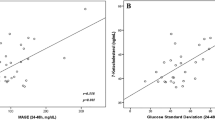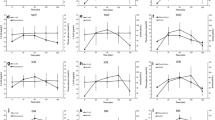Abstract
1,5-anhydroglucitol (1,5-AG) has been suggested as a marker for short-term glycemic control and postprandial hyperglycemia. However, the role of 1,5-AG in glycemic variability has not been established. The aim of this study was to demonstrate the usefulness of 1,5-AG as a marker for glycemic variability in patients with type 2 diabetes. Sixty patients with type 2 diabetes were enrolled, and a continuous glucose monitoring system (CGMS) was applied for 72 h. Continuous overlapping net glycemic action (CONGA), mean amplitude of glycemic excursion (MAGE), and mean of the daily differences (MODD) were calculated for the assessment of glycemic variability and compared with 1,5-AG. Urinary 8-iso prostaglandin F2α (8-isoPGF2α) was measured to assess oxidative stress. 1,5-AG was correlated with fasting blood glucose, HbA1c, postprandial area under the curve for glucose above 180 mg/dL (AUC-180), and mean post-meal maximum glucose (MPMG). However, 1,5-AG did not show significant correlation with CONGA-1, MAGE, and MODD (R = −0.053, P = 0.689; R = −0.148, P = 0.259; R = −0.123, P = 0.350). In patients with HbA1c ≤ 8.0% (n = 35), 1,5-AG was significantly correlated with HbA1c, mean glucose, postprandial AUC-180, and MPMG. However, in patients with HbA1c > 8.0% (n = 25), 1,5-AG did not show correlation with any glycemic markers. Oxidative stress measured as urine 8-isoPGF2α showed positive correlations with CONGA-1, MAGE, AUC-180, postprandial AUC-180, and MPMG only in men. However, 1,5-AG did not correlate with oxidative stress. Our data suggested a limited usefulness of 1,5-AG in estimating glycemic variability and oxidative stress. 1,5-AG was able to represent mean glucose and postprandial hyperglycemia only in well-controlled diabetic patients.
Similar content being viewed by others
Abbreviations
- 1,5-AG:
-
1,5-anhydroglucitol
- CGMS:
-
Continuous glucose monitoring system
- CONGA-1:
-
Continuous overlapping net glycemic action calculated with 1 h time intervals
- MAGE:
-
Mean amplitude of glycemic excursion
- MODD:
-
Mean of the daily differences
- 8-isoPGF2α :
-
8-iso prostaglandin F2α
- AUC-180:
-
Area under the curve for glucose above 180 mg/dL
- MPMG:
-
Mean post-meal maximum glucose
- SMBG:
-
Self monitoring of blood glucose
- SD:
-
Standard deviation
- GFR:
-
Glomerular filtration rate
- BMI:
-
Body mass index
References
Stratton IM, Adler AI, Neil HA, Matthews DR, Manley SE, Cull CA, Hadden D, Turner RC, Holman RR (2000) Association of glycaemia with macrovascular and microvascular complications of type 2 diabetes (UKPDS 35): prospective observational study. BMJ 321:405–412
Quagliaro L, Piconi L, Assaloni R, Martinelli L, Motz E, Ceriello A (2003) Intermittent high glucose enhances apoptosis related to oxidative stress in human umbilical vein endothelial cells: the role of protein kinase C and NAD(P)H-oxidase activation. Diabetes 52:2795–2804
Monnier L, Mas E, Ginet C, Michel F, Villon L, Cristol JP, Colette C (2006) Activation of oxidative stress by acute glucose fluctuations compared with sustained chronic hyperglycemia in patients with type 2 diabetes. JAMA 295:1681–1687
Ceriello A, Esposito K, Piconi L, Ihnat MA, Thorpe JE, Testa R, Boemi M, Giugliano D (2008) Oscillating glucose is more deleterious to endothelial function and oxidative stress than mean glucose in normal and type 2 diabetic patients. Diabetes 57:1349–1354
Monnier L, Colette C, Mas E, Michel F, Cristol JP, Boegner C, Owens DR (2010) Regulation of oxidative stress by glycaemic control: evidence for an independent inhibitory effect of insulin therapy. Diabetologia 53:562–571
Su G, Mi S, Tao H, Li Z, Yang H, Zheng H, Zhou Y, Ma C (2011) Association of glycemic variability and the presence and severity of coronary artery disease in patients with type 2 diabetes. Cardiovasc Diabetol 10:19
Siegelaar SE, Holleman F, Hoekstra JB, DeVries JH (2010) Glucose variability; does it matter? Endocr Rev 31:171–182
American Diabetes Association (2011) Standards of medical care in diabetes–2011. Diabetes Care 34(Suppl 1):S11–S61
Hu Y, Liu W, Chen Y, Zhang M, Wang L, Zhou H, Wu P, Teng X, Dong Y, Zhou J, Xu H, Zheng J, Li S, Tao T, Jia Y (2010) Combined use of fasting plasma glucose and glycated hemoglobin A1c in the screening of diabetes and impaired glucose tolerance. Acta Diabetol 47:231–236
American Diabetes Association (2001) Postprandial blood glucose. Diabetes Care 24:775–778
Koga M, Saito H, Mukai M, Matsumoto S, Kasayama S (2010) Influence of iron metabolism indices on glycated haemoglobin but not glycated albumin levels in premenopausal women. Acta Diabetol 47:65–69
Koga M, Murai J, Saito H, Mukai M, Kasayama S (2010) Serum glycated albumin, but not glycated haemoglobin, is low in relation to glycemia in hyperuricemic men. Acta Diabetol 47:173–177
Lee EY, Lee BW, Kim D, Lee YH, Kim KJ, Kang ES, Cha BS, Lee EJ, Lee HC (2010) Glycated albumin is a useful glycation index for monitoring fluctuating and poorly controlled type 2 diabetic patients. Acta Diabetol (in press)
Koga M, Saito H, Mukai M, Otsuki M, Kasayama S (2009) Serum glycated albumin levels are influenced by smoking status, independent of plasma glucose levels. Acta Diabetol 46:141–144
Suwa T, Ohta A, Matsui T, Koganei R, Kato H, Kawata T, Sada Y, Ishii S, Kondo A, Murakami K, Katabami T, Tanaka Y (2010) Relationship between clinical markers of glycemia and glucose excursion evaluated by continuous glucose monitoring (CGM). Endocr J 57:135–140
Buse JB, Freeman JL, Edelman SV, Jovanovic L, McGill JB (2003) Serum 1, 5-anhydroglucitol (GlycoMark): a short-term glycemic marker. Diabetes Technol Ther 5:355–363
Yamanouchi T, Minoda S, Yabuuchi M, Akanuma Y, Akanuma H, Miyashita H, Akaoka I (1989) Plasma 1, 5-anhydro-D-glucitol as new clinical marker of glycemic control in NIDDM patients. Diabetes 38:723–729
Yamanouchi T, Ogata N, Tagaya T, Kawasaki T, Sekino N, Funato H, Akaoka L, Miyashita H (1996) Clinical usefulness of serum 1, 5-anhydroglucitol in monitoring glycaemic control. Lancet 347:1514–1518
Pal A, Farmer AJ, Dudley C, Selwood MP, Barrow BA, Klyne R, Grew JP, McCarthy MI, Gloyn AL, Owen KR (2010) Evaluation of serum 1, 5 anhydroglucitol levels as a clinical test to differentiate subtypes of diabetes. Diabetes Care 33:252–257
McGill JB, Cole TG, Nowatzke W, Houghton S, Ammirati EB, Gautille T, Sarno MJ (2004) Circulating 1, 5-anhydroglucitol levels in adult patients with diabetes reflect longitudinal changes of glycemia: a U.S. trial of the GlycoMark assay. Diabetes Care 27:1859–1865
Dungan KM, Buse JB, Largay J, Kelly MM, Button EA, Kato S, Wittlin S (2006) 1, 5-anhydroglucitol and postprandial hyperglycemia as measured by continuous glucose monitoring system in moderately controlled patients with diabetes. Diabetes Care 29:1214–1219
Stettler C, Stahl M, Allemann S, Diem P, Schmidlin K, Zwahlen M, Riesen W, Keller U, Christ E (2008) Association of 1, 5-anhydroglucitol and 2-h postprandial blood glucose in type 2 diabetic patients. Diabetes Care 31:1534–1535
Dungan KM (2008) 1, 5-anhydroglucitol (GlycoMark) as a marker of short-term glycemic control and glycemic excursions. Expert Rev Mol Diagn 8:9–19
Yamanouchi T, Moromizato H, Shinohara T, Minoda S, Miyashita H, Akaoka I (1992) Estimation of plasma glucose fluctuation with a combination test of hemoglobin A1c and 1, 5-anhydroglucitol. Metabolism 41:862–867
Kishimoto M, Yamasaki Y, Kubota M, Arai K, Morishima T, Kawamori R, Kamada T (1995) 1, 5-Anhydro-D-glucitol evaluates daily glycemic excursions in well-controlled NIDDM. Diabetes Care 18:1156–1159
Levey AS, Bosch JP, Lewis JB, Greene T, Rogers N, Roth D (1999) A more accurate method to estimate glomerular filtration rate from serum creatinine: a new prediction equation. Modification of diet in renal disease study group. Ann Intern Med 130:461–470
Nyback-Nakell A, von Heijne M, Adamson U, Lins PE, Landstedt-Hallin L (2004) Accuracy of continuous nocturnal glucose screening after 48 and 72 hours in type 2 diabetes patients on combined oral and insulin therapy. Diabetes Metab 30:517–521
McDonnell CM, Donath SM, Vidmar SI, Werther GA, Cameron FJ (2005) A novel approach to continuous glucose analysis utilizing glycemic variation. Diabetes Technol Ther 7:253–263
Service FJ, Molnar GD, Rosevear JW, Ackerman E, Gatewood LC, Taylor WF (1970) Mean amplitude of glycemic excursions, a measure of diabetic instability. Diabetes 19:644–655
Fujisawa T, Ikegami H, Tsutsui T, Kawaguchi Y, Ueda H, Shintani M, Nojima K, Kawabata Y, Ono M, Nishino M, Noso S, Yamada K, Babaya N, Ogihara T (1999) Renal tubular function affects glycosuria-related urinary excretion of 1, 5-anhydroglucitol. Diabetes Care 22:863–864
Stickle D, Turk J (1997) A kinetic mass balance model for 1, 5-anhydroglucitol: applications to monitoring of glycemic control. Am J Physiol 273:E821–E830
Herman WH, Dungan KM, Wolffenbuttel BH, Buse JB, Fahrbach JL, Jiang H, Martin S (2009) Racial and ethnic differences in mean plasma glucose, hemoglobin A1c, and 1, 5-anhydroglucitol in over 2000 patients with type 2 diabetes. J Clin Endocrinol Metab 94:1689–1694
Block G, Dietrich M, Norkus EP, Morrow JD, Hudes M, Caan B, Packer L (2002) Factors associated with oxidative stress in human populations. Am J Epidemiol 156:274–285
Acknowledgments
This study was supported by a grant from the Ministry for Health, Welfare & Family Affairs, Republic of Korea (the Korea Healthcare 21 R & D Project: 00-PJ3-PG6-GN07-001 and the Innovative Research Institute for Cell Therapy: A062260).
Author information
Authors and Affiliations
Corresponding author
Rights and permissions
About this article
Cite this article
Kim, M.J., Jung, H.S., Hwang-Bo, Y. et al. Evaluation of 1,5-anhydroglucitol as a marker for glycemic variability in patients with type 2 diabetes mellitus. Acta Diabetol 50, 505–510 (2013). https://doi.org/10.1007/s00592-011-0302-0
Received:
Accepted:
Published:
Issue Date:
DOI: https://doi.org/10.1007/s00592-011-0302-0




